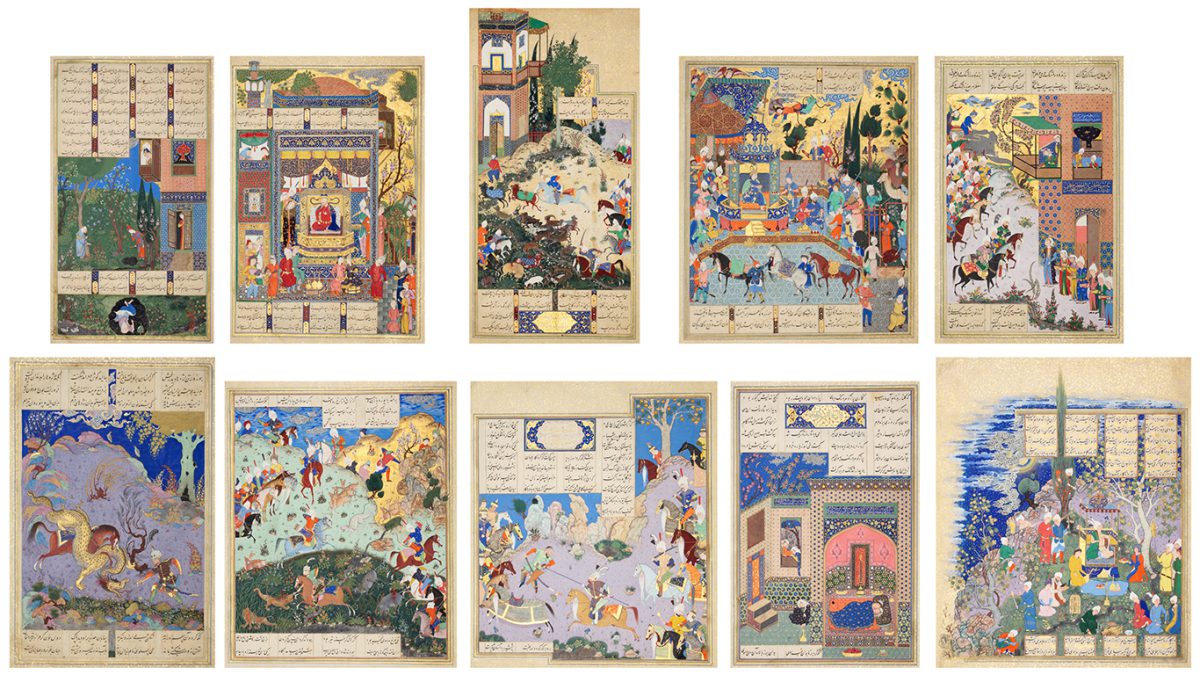



Title: Ten Folios from the Copy of Firdawsi ‘s Shahnamah Made for Shah Tahmasp (Houghton Shahnamah)
Date: 1520s – 1540s (manuscript); folio 516b dated 934 AH (1527–8 AD)
Location: Tabriz, Iran
Materials: ink, gold and opaque watercolour on paper; margins heavily sprinkled with gold
Dimensions: 47 x 32cm (folio)
Accession Number: MSS 1030
Other Notes:
The Shahnamah of Shah Tahmasp
Thanks to the conquests of the first Safavid ruler Shah Isma‘il I (r 1501–1524), his capital, Tabriz, inherited two great traditions of Persian painting: one from the court scriptorium of Timurid Herat, and the equally brilliant but lesser known scriptorium of the Aqqoyunlu Turcomans at Tabriz. Their fusion was to give rise to the finest illustrated Persian manuscript ever made, the so-called ‘Houghton’ Shahnamah (after the collector who broke it up in New York in the 1970s). It may have been begun before Shah Isma‘il’s death in 1524, possibly to commemorate the return of his young son, Tahmasp, who though little more than an infant had been sent to Herat as its governor. Of large format, it is written in calligraphic nasta‘liq, on fine paper, brilliantly illuminated and gold-sprinkled and was furnished with 258 illustrations. Its production, even with a large team of fine painters and other craftsmen, certainly took more than a decade and may even have continued into the 1540s, involving a second generation of painters. The format is independently conceived for each painting and must have involved constant consultation between scribes, painters and marginators.
Given this essentially corporate workmanship, with tried masters working side-by-side with pupils and apprentices, we might expect a uniformity of style and a more-or-less deliberate elimination of individuality, but in fact marked differences occur. General features, however, include a new approach to the technique of painting in opaque watercolour: treating the paint as if it were colour wash; a new subtlety of shading and modelling in pastel tones; the building up of tones and the enhancement of colour by gilding and silvering; and the use of mother-of-pearl and powdered talc to give sparkle. Stylistically, moreover, no attempt is made to present the heroes of the epic as historical characters; on the contrary, they are Safavid princes, soldiers and courtiers, and the details of their costumes, arms and armour, horse trappings and furniture remain an unsurpassed document of the rich material culture of the age.
The manuscript was given by Shah Tahmasp to the Ottoman Sultan Selim II at the time of the latter’s accession in 1566. By 1903, the manuscript was in the possession of Edmond de Rothschild. It changed hands once again in the early 1960s, when its then owner, Arthur Houghton Jr, began to disperse it. Today, some 140 of its paintings are in museums and collections throughout the world. The rest of the manuscript – the binding, the text block and 118 paintings – have been in the Contemporary Art Museum in Tehran since 1994.
The Khalili folios
Folio 25b The death of King Mirdas [see MSS 1030, folio 25]
Folio 27b Zahhak receives the daughters of Jamshid [see MSS 1030, folio 27]
Folio 30b Zahhak slays the sacred cow Barmayah [see MSS 1030, folio 30]
Folio 38b Faridun’s mother Faranak sends gifts to her son [see MSS 1030, folio 38]
Folio 89b Mihrab’s wife, Sindukht, comes out with slaves carrying gifts to welcome Sam [see MSS 1030, folio 89]
Folio 119b Rustam slays a dragon [see MSS 1030, folio 119]
Folio 135b Rustam and the Seven Warriors at the hunting-ground of Afrasiyab [see MSS 1030, folio 135]
Folio 279b The combat of Rustam and Shangul [see MSS 1030, folio 279]
Folio 516b Ardavan’s slave-girl Gulnar with the young Ardashir [see MSS 1030, folio 516]
Folio 731a The musician Barbad conceals himself in a tree [see MSS 1030, folio 731]
Script:
text copied in a superior nasta‘liq script, headings in riqa‘; with 22 lines to the page, arranged in 4 columns, two to a couplet; headings generally occupying the space of 2 couplets
Bibliography:
J.M. Rogers, The Arts of Islam. Masterpieces from the Khalili Collection, London 2010, cat.299–308, pp. 262–69.
Zoom
Close

Create your own collection of artworks that you can print or save as a PDF. Please enter you email to enable feature.
Small Flask | JLY 1075
Has been added to your collection.
TIP:
You can now access and view your collection from the main menu at any time.